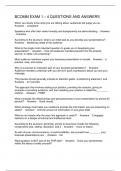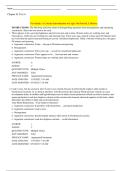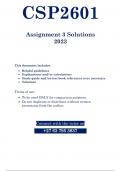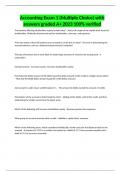21AB
Magnetic resonance imaging (MRI)
It is an advanced medical imaging technique used to visualize the internal structures of the
human body. It is a non-invasive procedure and does not expose patients to radiation. A strong
magnetic field and radio waves are used to generate high-resolution images of organs, structures,
etc.
Importance
It is important because the scan provides essential diagnostic information to healthcare
professionals. It is essential in the detection of tumors, infections, neurological disorders, etc.
MRI can detect abnormalities that are not usually detected by other imaging techniques, this
allows early diagnosis, accurate assessment of disease progression and precise treatment
planning.
How does it work?
The protons in hydrogen atoms are the key components in the MRI process, they are found in the
human body in water and fat molecules, and they will act as mini magnets.
The spinning protons create a magnetic field, so once the magnet is on, the protons will line up.
Most of the protons will face North (low energy state) and a few will face South (high energy
state).
In order to add energy to an object vibrating it is necessary to add the energy at the same
frequency, so at the resonance stage, a radiowave pulse containing the same frequency as the
rotating protons is emitted. The protons will gain energy by absorbing radiowave (excitation) and
that will cause the protons to flip, so now most of the protons will be facing South (high energy
state).
The radiowave is turned off and that makes the protons lose energy, going back to their original
position (relaxation), the protons emit a signal that is received by the coil and processed by a
computer. The signal emitted is different for different tissues due to the level of excitation.
Spin- spin relaxation: one proton loses energy to another proton, which keeps the same number
of protons with high and low energy state
Spin- lattice: one proton loses energy to the atoms around it to the surrounding tissue, the
machine can detect the heat that is being given off and how quickly the energy is being lost, this
indicates the type of molecule.
,Parts of the body
When it comes to the brain, MRI is usually used to examine its structures, including the cerebral
cortex, ventricles, and main blood vessels. When it comes to the spine, MRI assesses the spinal
cord, intervertebral discs, and surrounding tissues, in order to diagnose conditions such as
herniated discs, and spinal tumors. When assessing the heart and blood vessels, MRI evaluates
their structure, function, and blood flow, which provides information about heart chambers,
valves, as well as conditions such as blockages. Additionally, MRI is effective in imaging
muscles, ligaments, and other soft tissues in the body, which allows the diagnosis of sports
injuries, tumors, and inflammatory conditions. However, other imaging modalities like X-rays
and CT scans may be more suitable for certain areas of the body or conditions.
Advantages:
MRI offers many advantages in the imaging field. It provides detailed and high-definition
imagines of soft tissues, organs and internal structures that enable precise diagnosis and
evaluation of many medical conditions.
It is a non-invasive technique that it does not use ionizing radiation, this ensures patient safety,
and it is a good option for patients that require multiple scans or belong to vulnerable groups
such as children and pregnant woman.
Also, MRI is highly versatile, it generates images from different angles and orientations which
provides complete information to guide professionals on surgical planning and the best treatment
decisions.
Disadvantages:
Even with so many advantages, MRI also has a few disadvantages. One limitation is the high
cost, it is complex equipment, and its maintenance is also expensive, this makes MRI less
accessible in some healthcare settings.
, Another disadvantage is the time it takes to obtain the images, patients are usually required to
stay still between 15 to 30 minutes inside the machine, this can be uncomfortable for patients,
especially for those who experience claustrophobia or struggle with keeping still.
Functional MRI
How does it work?
When an area of the brain is being used (e.g., reading a book), the neural activity in that area
increases, this will require a higher demand of oxygen which increases blood flow.
Oxyhaemoglobin (haemoglobin with oxygen) does not absorb radio wave signals, and because
more oxygen is absorbed from the blood, the oxyhaemoglobin levels increase.
The less radio waves absorbed, the higher the level of activity in that area, which indicates the
best that part of the brain is working.
The rate that energy is being released by the tissue is used to identify the matter (white; grey).
Ultrasound
An ultrasound scan, also known as a sonogram, uses high-frequency sound waves to create
images of internal body structures. This procedure can be used to monitor the development of a
fetus, diagnose medical conditions, and provide guidance to surgeons during specific procedures.
Ultrasound refers to sound waves with frequencies higher than the upper limit of human hearing,
above 20 kHz, the size of the wavelength in ultrasound is inversely proportional to the
frequency, so as the frequency increases, the wavelength decreases.
Importance
Ultrasound plays an important role in the medical field by providing valuable information about
organ structure and function. Real-time imaging allows doctors to observe structures,
movements, and changes, which facilitates the guidance of procedures and interventions.
Ultrasound is used as a reliable tool for monitoring the progress and regression of conditions,
tracking fetal development, assessing treatment response, and evaluating healing processes.
Probe
Magnetic resonance imaging (MRI)
It is an advanced medical imaging technique used to visualize the internal structures of the
human body. It is a non-invasive procedure and does not expose patients to radiation. A strong
magnetic field and radio waves are used to generate high-resolution images of organs, structures,
etc.
Importance
It is important because the scan provides essential diagnostic information to healthcare
professionals. It is essential in the detection of tumors, infections, neurological disorders, etc.
MRI can detect abnormalities that are not usually detected by other imaging techniques, this
allows early diagnosis, accurate assessment of disease progression and precise treatment
planning.
How does it work?
The protons in hydrogen atoms are the key components in the MRI process, they are found in the
human body in water and fat molecules, and they will act as mini magnets.
The spinning protons create a magnetic field, so once the magnet is on, the protons will line up.
Most of the protons will face North (low energy state) and a few will face South (high energy
state).
In order to add energy to an object vibrating it is necessary to add the energy at the same
frequency, so at the resonance stage, a radiowave pulse containing the same frequency as the
rotating protons is emitted. The protons will gain energy by absorbing radiowave (excitation) and
that will cause the protons to flip, so now most of the protons will be facing South (high energy
state).
The radiowave is turned off and that makes the protons lose energy, going back to their original
position (relaxation), the protons emit a signal that is received by the coil and processed by a
computer. The signal emitted is different for different tissues due to the level of excitation.
Spin- spin relaxation: one proton loses energy to another proton, which keeps the same number
of protons with high and low energy state
Spin- lattice: one proton loses energy to the atoms around it to the surrounding tissue, the
machine can detect the heat that is being given off and how quickly the energy is being lost, this
indicates the type of molecule.
,Parts of the body
When it comes to the brain, MRI is usually used to examine its structures, including the cerebral
cortex, ventricles, and main blood vessels. When it comes to the spine, MRI assesses the spinal
cord, intervertebral discs, and surrounding tissues, in order to diagnose conditions such as
herniated discs, and spinal tumors. When assessing the heart and blood vessels, MRI evaluates
their structure, function, and blood flow, which provides information about heart chambers,
valves, as well as conditions such as blockages. Additionally, MRI is effective in imaging
muscles, ligaments, and other soft tissues in the body, which allows the diagnosis of sports
injuries, tumors, and inflammatory conditions. However, other imaging modalities like X-rays
and CT scans may be more suitable for certain areas of the body or conditions.
Advantages:
MRI offers many advantages in the imaging field. It provides detailed and high-definition
imagines of soft tissues, organs and internal structures that enable precise diagnosis and
evaluation of many medical conditions.
It is a non-invasive technique that it does not use ionizing radiation, this ensures patient safety,
and it is a good option for patients that require multiple scans or belong to vulnerable groups
such as children and pregnant woman.
Also, MRI is highly versatile, it generates images from different angles and orientations which
provides complete information to guide professionals on surgical planning and the best treatment
decisions.
Disadvantages:
Even with so many advantages, MRI also has a few disadvantages. One limitation is the high
cost, it is complex equipment, and its maintenance is also expensive, this makes MRI less
accessible in some healthcare settings.
, Another disadvantage is the time it takes to obtain the images, patients are usually required to
stay still between 15 to 30 minutes inside the machine, this can be uncomfortable for patients,
especially for those who experience claustrophobia or struggle with keeping still.
Functional MRI
How does it work?
When an area of the brain is being used (e.g., reading a book), the neural activity in that area
increases, this will require a higher demand of oxygen which increases blood flow.
Oxyhaemoglobin (haemoglobin with oxygen) does not absorb radio wave signals, and because
more oxygen is absorbed from the blood, the oxyhaemoglobin levels increase.
The less radio waves absorbed, the higher the level of activity in that area, which indicates the
best that part of the brain is working.
The rate that energy is being released by the tissue is used to identify the matter (white; grey).
Ultrasound
An ultrasound scan, also known as a sonogram, uses high-frequency sound waves to create
images of internal body structures. This procedure can be used to monitor the development of a
fetus, diagnose medical conditions, and provide guidance to surgeons during specific procedures.
Ultrasound refers to sound waves with frequencies higher than the upper limit of human hearing,
above 20 kHz, the size of the wavelength in ultrasound is inversely proportional to the
frequency, so as the frequency increases, the wavelength decreases.
Importance
Ultrasound plays an important role in the medical field by providing valuable information about
organ structure and function. Real-time imaging allows doctors to observe structures,
movements, and changes, which facilitates the guidance of procedures and interventions.
Ultrasound is used as a reliable tool for monitoring the progress and regression of conditions,
tracking fetal development, assessing treatment response, and evaluating healing processes.
Probe










